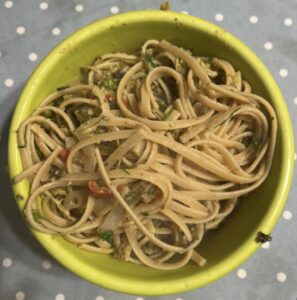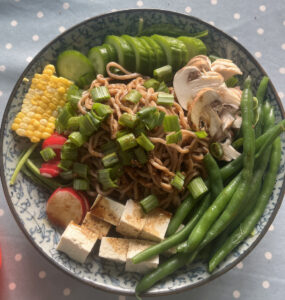A couple of weeks ago I finished reading Starhawk’s new book, City of Refuge. I was very much looking forward to it, being a long-time fan of Walking to Mercury and The Fifth Sacred Thing. And it was an overall enjoyable experience: familiar characters experiencing new adventures. The two later novels in the chronology are set in the 2040s, after an ecological disaster affects California, splitting it into a Northern utopia-in-recovery and a Southern patriarchal theocracy. The novels interrogate the possibilities that these futures offer by incorporating many elements of present-life Bay Area delights and keeping the environmental stuff as real as possible: San Francisco (“Califia”) is a city of water, in which people shuttle around in gondolas on the river, a-la The Blue Greenway.
But there is one aspect of the new book that made me cringe with discomfort. One of my favorite ecofeminist heroes and authors got it wrong–very wrong–with regard to food.
The citizens of Califia eat very well, and their concoctions, as well as Bay Area booze, are extensively described in the book, especially contrasted to the faux-nutrition “chips” and “sweeties” consumed by the Southerners. Indeed, echoing and crystallizing much of the recent scholarship on our consumption of faux foods, the Southerners have a hard time adjusting to the real food in the north. The book made me feel like Starhawk conjured her favorite meals from the present and planted them in a future in which people’s agricultural ingenuity strives the overcome the effects of an ecological horror. Much time is spent in the book on the ways in which my beloved heroes, Madrone and Bird, start their “city of refuge” in the South by starting agricultural production, and the (real) magic of compost is explored in depth.
But what is on the menu in Califia? Much to my surprise, quite a lot of meat, cheese, and eggs, sometimes (but not often) hailed as “humanely raised.” Our heroes are served beef and chicken and lamb, eat honey by the bushels, and enjoy dairy with quite some frequency. Oh, there are vegans, of course, but that’s briefly described as a “personal choice”, with an “option” to order a chickpea-quinoa stew at a restaurant, side by side with the default meat choices.
Not only is this a deeply upsetting culinary repertoire for a presumed utopia, but it’s also massively unrealistic, because one has got to ask oneself–where the heck do they even raise all these animals?
Surely, Starhawk must be aware of the massive contribution of animal pasture areas and feedlots to the deforestation and corruption of the earth. Surely she knows that every burger we eat is the equivalent of months of showering. Surely she’s heard of waste and manure lagoons covering vast areas and endangering our health. As an avid permaculturist, surely she knows that vegan options are possible, realistic, and cost-effective. In a future affected by climate change, veganism will not be a “personal choice”–it will be a fact of life for everyone.
And, where are all these mysterious cows, lambs, and chickens raised? Where do the chickens lay their eggs? Where are the utopian slaughterhouses? Or do we just not like to talk about the fact that meat comes from animals?
And that’s before we even discuss the cruelty involved in the gratuitous raising and killing of animals for our own consumption, which doesn’t even begin to be portrayed as being at odds with the deeply Pagan, one-with-nature vibe of Califia. People pray over their food and give thanks to the animals–to the Goddess, to spirit, to whatever–which may make them feel great and a part of the cycle of life, but all these spiritual feel-good florid incantations don’t actually affect the animal’s fate one bit. For more on the “but I express gratitude for my wild salmon” sensibility and its hypocrisy, read Sherry Colb’s excellent Mind If I Order the Cheeseburger?, focusing on the chapter on Native Americans.
Actually, without much effort one could envision a Northern Californian utopia just by looking at one marvelous permacultural initiative: the food forest. Here are several examples of food forests around the world, and for the Hebrew readers among you here’s a great story about the new one in Israel. The animals in food forests aren’t “raised”: they LIVE there. Birds nest in the trees, rodents run around collecting nuts, etc. To the extent that we benefit from their presence there, it’s as we would from any naturally-occurring phenomenon.
A world in which all the territories formerly devoted to animal farming are repurposed as food forests and homes for wild animals? Now THAT’s what I would consider a really inspiring utopia.





No comment yet, add your voice below!